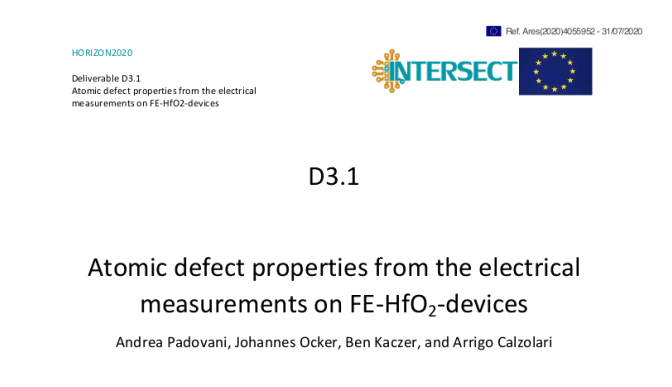
25 Aug #Deliverable 3.1 “Atomic defect properties from the electrical measurements on FE-HfO2-devices”
As we recently posted, new INTERSECT project deliverables are out! Deliverable 3.1 “Atomic defect properties from the electrical measurements on FE-HfO2 devices“, by our intersecters Andrea Padovani, Johannes Ocker, Ben Kaczer, and Arrigo Calzolari, developed within Work Package 3, “Testing and piloting”, and its task n. 3.1, “FE-transistor and FE-memories: Extraction of defect properties from electrical measurements”, with IMEC as task leader and contribution from CNR, ICN2, EPFL, MDLab, FMC, IMEC.
Executive summary: This document provides a description of the use of the device cycle of the IM2D Simulation box to extract material and defect properties from the interpretation of the electrical data measured on ferroelectric devices.
The task activities rely on the use of the Defect Discovery Tool (DDT) functionalities implemented into AMAT proprietary GinestraTM platform, which are specifically developed to extract intrinsic material/device properties (e.g. bandgap, thicknesses, etc.) and characteristics of the defects (e.g. thermal ionization and relaxation energies, distribution within the bandgap) from electrical measurements.
DDT functionalities are applied to current-voltage and threshold voltage shifts (ΔVT) characteristics measured respectively on Silicon-Ferroelectric-Silicon (SFS) capacitors and high-k/metal gate (HKMG) ferroelectric transistors with doped FE-HfO2. Devices and electrical measurements are provided by IMEC and FMC units.
Consistent results are obtained for the data and devices considered and show that both charge transport and ΔVT are originated by a different trap state with respect to the ones typically reported for conventional HfO2. The similarities found between the properties extracted using the DDT for the defects in doped HfO2 of both SFS and HKMG devices suggest that these traps may be related to specific features of the FE-HfO2 structure that are at the bases of the ferroelectricity in this material.
Info & Download: Padovani, A., Ocker, J., Kaczer, B., Calzolari, A. (2020): “Atomic defect properties from the electrical measurements on FE-HfO2-devices. Deliverable D3.1 of the H2020 project INTERSECT” (final version as of 30/01/2020), EC grant agreement no: 814487, Applied Materials, Reggio-Emilia, Italy.
Keep up to date with all our project deliverables!



Sorry, the comment form is closed at this time.